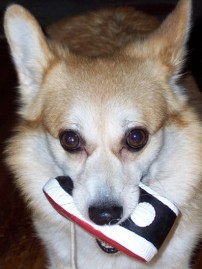It took my little Corgi only three or four car rides before she’d taught herself a trick, not that I realized it was a trick at first. I’d put her crate in the car and had led her out on her leash. I bent over to pick her up, and at the same time, she jumped up. I wasn’t ready. I got a mouthful of dog fur. Fortunately, I didn’t drop her.
On subsequent occasions I did better, and came to admire her little move. The “cue” is partially contextual (crate in the car) and partly my body language: my bending over is her signal to jump. She gives a little leap and I’ve got a Corgi in my arms.
Her best untaught “tricks,” of course, are those involving food. My parents free-feed their four cats from dishes on their kitchen floor. So naturally, my dog dashes for that part of the kitchen the second she enters my parents’ house. Sometimes one of us remembers to pick up the dishes before I let her loose. Sometimes we forget.
Fortunately my dog hasn’t learned to take the shortest route to the dishes. This is probably due to sheer excitement: she runs straight into the house, her momentum propelling her into the living room, then doubles back via the dining room into the kitchen.
I, meanwhile, have suddenly remembered the cat food, and take a shortcut to head Laykey off. So about 5 feet from her prize, she finds me blocking the way, and has to throw on all four brakes to prevent a collision. She doesn’t seem particularly bothered, however. There are usually a few crumbs of dry food on the floor, and plenty of flavor left in any empty cat dishes lying around.
The cat food on the cellar steps is a different matter. Laykey is a timid dog — “reactive” in the current parlance — and until recently never dared venture into any basement. We humans, diabolical creatures that we are, have turned this to our advantage: we move the full cat food dishes onto the cellar steps, beyond the dog’s reach, and partially close the door. Other than having to step over cats sometimes when we need to go down the stairs, this has worked out pretty well, from the humans’ perspective.
It’s a source of torment for my dog.
She stands at the top of the stairs, stretching her nose as far as she dares through the opening of the door. If there were a talk bubble over her head, it would read “If only I were a brave enough little doggy to go into the cellar!”
I suppose it was inevitable that, sooner or later, she’d work up the courage to try.
Cat food is, after all, delectable.
Only it worked out badly. The steps are narrow, and even under ideal circumstances Corgis aren’t shaped right for using stairs. Their bodies are long, their legs are short. They have to ascend and descend at a diagonal. Plus the cat dishes were in the way.
I was in the other room when I heard the crash. I sprang to the kitchen just in time to see my poor sausage-shaped little dog, rolling down the steps in a cascade of cat kibble and plastic dishes.
She wasn’t hurt. I carried her upstairs and put her in her crate, where she promptly threw up. Yes, she’d managed to gulp down two or three mouthfuls of cat food before the disaster.
Which means that, by some measures, the venture was a success. So now the unanswered question is: will she try this new trick again . . .
, which is coming out in June.
, which I co-wrote with Terry Ryan, a professional trainer. Tips is shorter — 12,000 words — and includes 50 photos, most of which I took myself. Outwitting Dogs came in at around 90,000 words, if I remember correctly.

